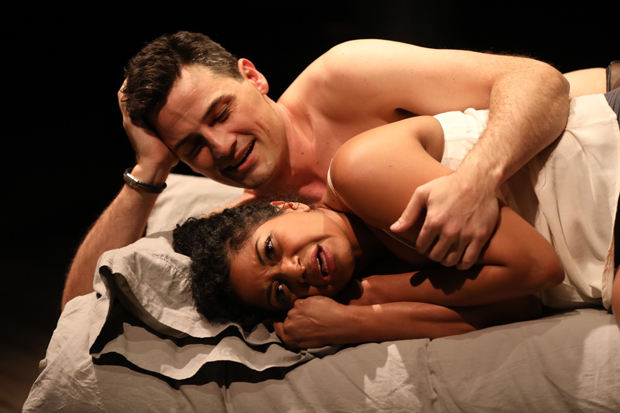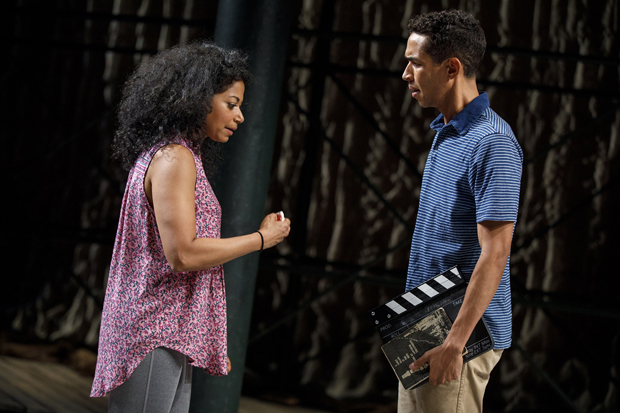Fire in Dreamland Ignites Imagination and Insecurity
Rinne Groff’s latest play depicts a Coney Island romance in the wake of Superstorm Sandy.

(© Joan Marcus)
Near the beginning of Rinne Groff's Fire in Dreamland (now playing at the Public Theater), a woman watches a short film clip and almost bursts into tears. Is it because this is the most beautiful example of cinema she has ever seen? Or, is it because the guy who shot it is a handsome Dutchman with whom she happens to be sleeping? Groff and director Marissa Wolf never come down on one side or the other and we never see the clip; but this fascinating and funny new play makes it clear that we have all witnessed a conversion — the kind of suspension of disbelief that all great artists (including those of the con variety) crave.
The woman in question is Kate (Rebecca Naomi Jones), a Coney Island resident who works for a public-private partnership and is very unhappy. She's crying on the boardwalk at the beginning of the play (several months after Superstorm Sandy) when she meets Jaap Hooft (Enver Gjokaj), a Dutch film student who is making a movie about the 1911 fire that destroyed the Dreamland amusement park. Kate is quickly drawn into his world, which includes late-night phone calls from Jaap's classmate, Lance (Kyle Beltran), and payments made to CGI experts in India using Bitcoin (the Dutch tulip of our age). She becomes the film's de facto producer and, in her mind, Jaap's muse. But is she just seeing what she wants to see?

(© Joan Marcus)
Jones makes an appealing and instantly relatable everywoman, fed up with her disappointing life and attracted to the romance of art described in a European accent. It's hard to judge her, especially since Gjokaj is every bit as charming as her behavior suggests. Even when the red flags shoot up, we don't want to heed them. The biggest red flag is Lance, a socially awkward twentysomething whom Beltran plays like the tin man before oiling, impressively managing to annunciate his lines without ever seeming to actually move his mouth. His physical expression is isolated to his clapperboard, a surrogate appendage through which Beltran dexterously conveys all manner of emotion while also controlling time.
Director Marissa Wolf has tightly staged this play with jump cuts, denoting a shift in scenes using only a slight pulse in the lights (subtly done by Amith Chandrashaker) and the clap of Lance's slate. Beltran sits upstage during most of Kate and Jaap's scenes, brooding under an expanse of New York City scaffolding. Susan Hilferty's set evokes both urban construction and the Coney Island boardwalk. The curvy blue backdrop behind that seems meant to evoke the waves crashing against beach, but (in the production's one major misstep) looks a lot more like the Wall in Game of Thrones.

(© Joan Marcus)
The whole design team collaborates on Kate's big monologue describing the climactic scene of Jaap's movie, in which a black lion escapes his animal tamer during the confusion of the fire. Brendan Aanes's ersatz Hans Zimmer score swells and red light flickers against the set as Jones enchants us with her words, forcing us to visualize the brave lion as he climbs to the top of the roller coaster like a feline King Kong. You may find yourself involuntarily reaching for popcorn.
Of course, aficionados of social media hoaxes will recognize Groff's reference to a black lion as an indicator of the truthfulness of Jaap's filmmaking, if not his entire being. At once fearsome and fantastical, the lion exemplifies a tradition of marketable BS stretching back to Barnum and beyond. With Fire in Dreamland, Groff makes a persuasive argument: That dishonesty exists because we want it to — because we prefer beautiful dreams to depressing reality. More alarmingly, it also illustrates the kind of destruction that can occur when such dreams go up in flames.








